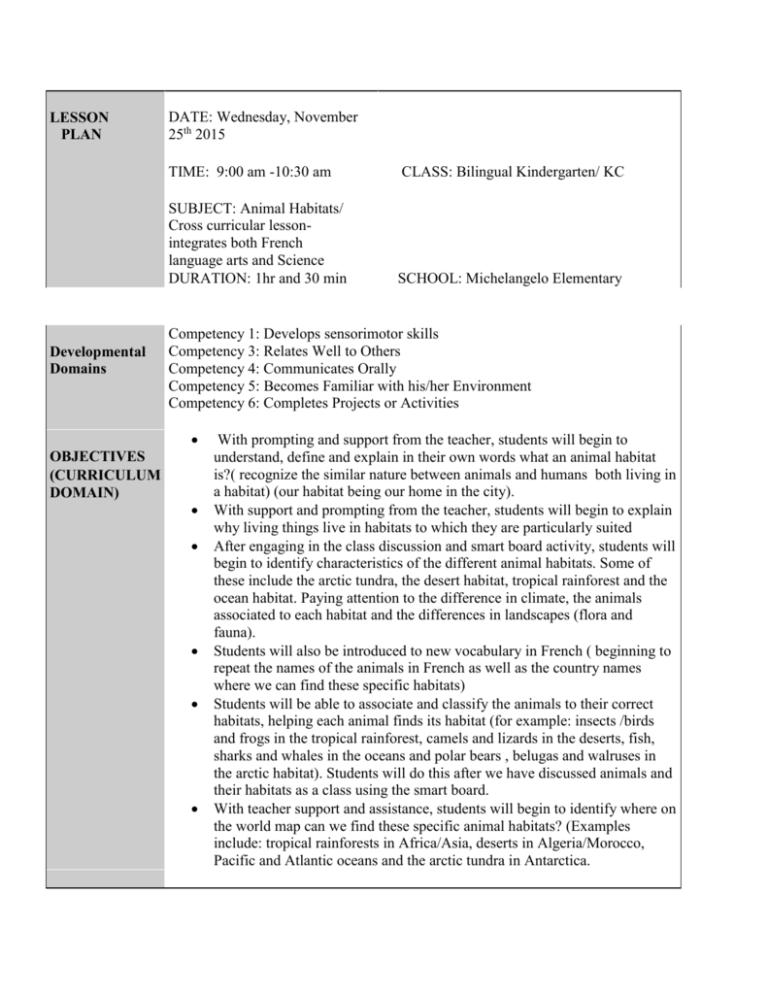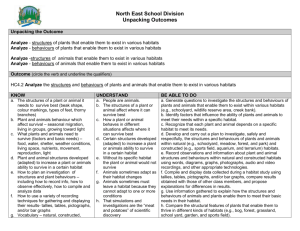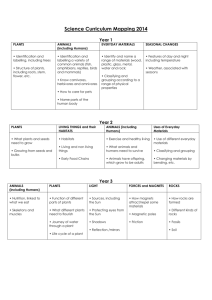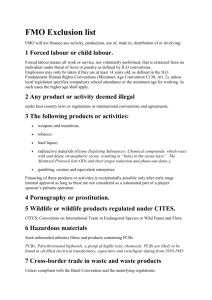to see highlighted part of french science/language arts lesson plan
advertisement

LESSON PLAN Developmental Domains DATE: Wednesday, November 25th 2015 TIME: 9:00 am -10:30 am CLASS: Bilingual Kindergarten/ KC SUBJECT: Animal Habitats/ Cross curricular lessonintegrates both French language arts and Science DURATION: 1hr and 30 min SCHOOL: Michelangelo Elementary Competency 1: Develops sensorimotor skills Competency 3: Relates Well to Others Competency 4: Communicates Orally Competency 5: Becomes Familiar with his/her Environment Competency 6: Completes Projects or Activities OBJECTIVES (CURRICULUM DOMAIN) With prompting and support from the teacher, students will begin to understand, define and explain in their own words what an animal habitat is?( recognize the similar nature between animals and humans both living in a habitat) (our habitat being our home in the city). With support and prompting from the teacher, students will begin to explain why living things live in habitats to which they are particularly suited After engaging in the class discussion and smart board activity, students will begin to identify characteristics of the different animal habitats. Some of these include the arctic tundra, the desert habitat, tropical rainforest and the ocean habitat. Paying attention to the difference in climate, the animals associated to each habitat and the differences in landscapes (flora and fauna). Students will also be introduced to new vocabulary in French ( beginning to repeat the names of the animals in French as well as the country names where we can find these specific habitats) Students will be able to associate and classify the animals to their correct habitats, helping each animal finds its habitat (for example: insects /birds and frogs in the tropical rainforest, camels and lizards in the deserts, fish, sharks and whales in the oceans and polar bears , belugas and walruses in the arctic habitat). Students will do this after we have discussed animals and their habitats as a class using the smart board. With teacher support and assistance, students will begin to identify where on the world map can we find these specific animal habitats? (Examples include: tropical rainforests in Africa/Asia, deserts in Algeria/Morocco, Pacific and Atlantic oceans and the arctic tundra in Antarctica. GROUP SIZE & MATERIALS The book “Moi j’habite” by Christopher Wormell The 4 information habitat series “24 heures” (dans l’arctique, sur un recif coralline, dans la savane and au Coeur des forets tropicales) The smartboard Ma premiere carte du monde Pictures of the habitats and animals to stick onto the map The habitat handout activity PROFESSIONAL COMPETENCIES: Competency 1: To act as a professional inheritor, critic and interpreter of knowledge when teaching students Competency 2: To communicate clearly in the language of instruction, both orally and in writing, using correct grammar, in various contexts related to teaching . Competency 3: To develop teaching/learning situations that are appropriate to the students concerned and the subject content with a view to developing the competencies targeted in the programs of study . Competency 4: To pilot teaching/learning situations that are appropriate to the students concerned and to the subject content with a view to developing the competencies targeted I the programs of study . Competency 5: To evaluate student progress in learning the subject content and mastering the related competencies Competency 6: To plan, organize and supervise a class in such a way as to promote students’ learning and social development TIME LESSON Introduction . The lesson will begin right after the calendar of the day/ morning routine. I will ask all the 9:00am- students to remain with their heads on their desks. When I call their table they will tip toe to the 9:15 am story telling corner for story time. I will introduce the lesson on animal habitats by reading the story “Moi j’habite” by Christopher Wormell. The book introduces the students to different animals and where they live. For example, je suis une abeille j’habite dans une ruche, je suis un chameau j’habit dans le désert etcc.. TIME LESSON Before reading the story, I will have the students look closely at the front cover of the book and I will read the title of the story. Then I will ask them to infer based on the title, what they think the book might be about? I will also ask the students to discuss in French, what they think a habitat is. I will emphasize on the word “habite” meaning live and ask them where they live. (Make connections to prior knowledge of a habitat/home). I will have them discuss who lives in their home and explain how just like we have a home to live in, animals also have homes that they live in. After reading the story, I will ask the student to discuss animals that are native to our part of the country. Which animals can we find in Canada? Some expected answers are squirrels, dogs, cats, beavers, birds and insects. Then I will branch out to other environmental habitats like the ocean, the rainforests, arctic and desert and ask students to think of some animals that live in these specific habitats. I will explain to the students, that there are many habitats around the world that different animals live in. For today, we will be closely examining four habitats in particular. These include the ocean, the desert, the arctic as well as the tropical rainforest. I will have four books on the desk opened next to me. These four books are informative books which provide lovely visuals of all the animals that live in each habitat and also provide information about the climate, the vegetation and the landscape. I will not be reading these books because they are not age appropriate, however, I will have the students browse the books and look at the pictures of the landscapes of each habitat and to identify in the images which animals live where. TIME LESSON I will also emphasize on the difference in climate, landscape and vegetation found within each of the habitats. For example, in the arctic habitat the climate is cold compared to the desert habitat. In the tropical rainforest, we will see much more vegetation than in the desert habitat. I want the students to begin to identify these differences. I will have the students examine the pictures and begin to ask them what kind of animals they see in the specific pictures in the books. This way, they begin to practice saying the names of the animals in French. Following this, I will begin the smart board activity. Each slide on the smart board will pertain to one of the four habitats examined for that day. On each slide, I have recorded specific sounds that we would hear in that specific habitat. I will be telling the students that we will be taking a walk in these different habitats and listen to the sounds we hear. While listening to the sound effects for each habitat, I will ask the students which animals they hear in the background and have them try to name them in French. For example, in the tropical rainforest we hear the sounds of birds chirping, monkey shrieking and the sound of the trickling rainfalls. In the ocean habitat, we hear the sound of the waves, dolphins whistling and the scuba diver breathing underwater. Following this, I will play an interactive smart board game with the students. On each slide, there will be a background picture of a specific habitat as well as different pictures of a variety of animals placed on the side of the picture of the habitat. The animals have all been scrambled and mixed up. The students will help me classify/associate the animals to their appropriate habitat by dragging them into the appropriate habitat. For example, polar bear goes in the arctic habitat, the camel goes lives in the desert, or the seahorse lives under the sea. Following this, I will discuss with the students different places/countries in the world where we can actually find these specific habitats. For example, tropical rainforests can be found in Africa, Asia and Australia, or the arctic habitat can be found in Antarctica. I will then have next to me hanging on the bristle board, a simplified version of a map of the world that I have made specifically for the students. I will then have pictures of each habitat mentioned during our discussion and I will have students come up and place the habitat in the TIME LESSON appropriate country on the map. This will be done with my support and assistance. Once the habitats have been placed in the correct countries on the map. I will have some students come up and place the specific animals we spoke about in the correct habitats on the map. This way, students will begin to identify where in the world we can find these habitats and will begin to understand and classify which animals go in which habitat and where in the world these animals actually live. As a form of assessment, I will then have the students go back to their desks and begin their activity for the day. The students will be asked to draw one of the four habitats we spoke about and then draw and color two animals that live in the specific habitat they chose. Once they are done drawing and coloring, I will have them come and see me so that I could write the animal’s name right next to their drawing. This graphic organizer will be a great assessment tool because I will be able to judge based on what the children decide to include in their drawings whether or not they were listening during our class discussion about habitats. Based on which animals they choose to include or associate with the specific habitat will help me gain insight on whether or not they actually understood the lesson and if my instructional approach to the subject matter was effective. TIME LESSON Evaluation: I will be evaluating the students understanding of animal habitats using a teachergenerated formative assessment rubric based on a three level performance scale (very good, satisfactory, has difficulty). I will be evaluating whether or not the students are fulfilling kindergarten competency three, four and five. I will be assessing students on their ability to relate well with the others in the class, competency three of the kindergarten program by observing who is participating in the class discussion following the reading of the book “Moi j’habite”. I will also be looking out for whether or not the students are listening to what their peers are saying as I will ask some of the students to repeat in their own words what another person has said. I will be evaluating the student’s ability to communicate orally in the appropriate language of instruction, competency four of the kindergarten program. I will assess whether or not the students are making an effort to use precise and specific vocabulary in French when trying to name the animals. I will also be assessing whether or not the students are able to make themselves understood in French when communicating orally during the class discussion. I will evaluate students on their familiarity with the environmental habitats and animals, competency 5 of the kindergarten program by using the habitat handout/graphic organizer as an assessment tool. Based on what the students choose to draw on the handout, I will be able to assess whether or not they understood our discussion and were listening during the smart board interactive game. The drawing should reflect the habitat chosen and the student should use the right colours and details to demonstrate their understanding of the landscape associated with the specific habitat chosen. Also the student will be assessed on whether or not they were able to associate the animals to their appropriate habitats. Differentiation: When planning for instruction of this specific animal habitat lesson, I made sure to take into consideration the preferred cognitive learning styles of the students in my class. I have decided to include a variety of learning experiences/methods of learning that best fit the students in my class and that allow students to explore their preferred learning styles. For the visual learners in my class, I have provided visual pictorial representations/images of the different habitats and the animals associated to the specific habitats. Students who are visual learners will remember and understand things when they are visually represented for them and can picture what they are learning in their heads. Therefore, I am being responsive to students who are visual learners by using methods that are primarily visual that way the students are “seeing what they are learning”. For the auditory learners in my class, I have decided to support the students understanding of the environmental habitats and animals associated with those habitats by having them listen to sounds that we would hear if we would take a walk in the specific environmental habitats. Auditory learners learn best when newly learnt information is transferred into sound. By listening carefully to the sounds, the students will be asked to identify the animals they hear and classify them in the appropriate habitats. For the kinesthetic learners in my class who learn best through hands-on experiences, I have provided students with tactile learning experiences where they are given the opportunity to come up and place the specific habitats on the map and also the animals associated with the specific habitats. These students learn best by “doing”, that means by manipulating materials, moving, touching and applying information to real world situations. This lesson provides an opportunity for kinesthetic learns to move and manipulate material when working on the map section of the lesson. This is also a preferred learning style for those students who exhibit spatial intelligence. These students are good at reading maps and think primarily in pictures. Therefore, the methods used for this specific lesson will definitely cater to all three of the main learning styles and will support the students learning towards the fulfillment of the learning standards/objectives of the lesson. In this way, I am providing a variety of learning experiences that are all geared towards ensuring that the learning is meaningful for all the students in the class. Self reflection: For this lesson, I would like to improve the following teaching skills: Classroom management- how to manage the students behavior and learning Anticipation of student challenges – being clear with instructions- also explaining the new information/instructions in different ways to ensure that all students have grasped the information Find different ways to check for understanding- other than asking “ does everyone understand” Challenging students to move beyond their comfort zone Time management skills- pace my teaching- be aware of the time( do not ignore classroom routine) Organizational skills Voice quality- lowering the tone of voice when teaching Providing more wait time between questions- offering students more time to think about the question Formulating questions that will encourage students to discover concepts on their own rather than revealing the answer within the question- reformulate questions in different ways to ensure that the students are understanding correctly Maintaining students focused attention Correcting mistakes students make when speaking Learning how to evaluate/observe for student understanding not only after the lesson but during- ongoing assessment- through informal discussions/conversations/ spot checking students work/ listening to their comments/ideas Making sure to write clearly and in an organized manner Smoother transitioning between one activity to the next- making the connections between the activities clear for the students- offering meaningful learning experiences.








